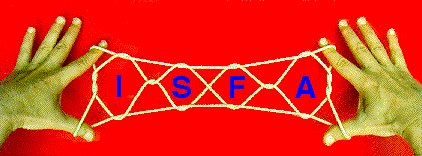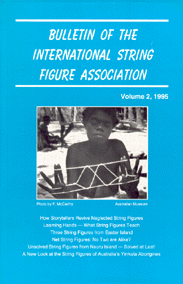Volume 2 (1995): 200 pages - Table des Matières
Edité par - Mark A. Sherman, Pasadena, California
Rédacteurs Associés - Joseph D'Antoni, Queens, New York; Myriam Namolaru, Haifa, Israel;
Belinda Holbrook, Davenport, Iowa; Stephan Claassen, Best, Netherlands.
Comité de Rédaction - Hiroshi Noguchi, Tokyo, Japan; Philip Noble, Inverness, Ecosse
Le Bulletin de l'Association Internationale du Jeu de Ficelle (BISFA) est une publication savante
présentant des documents originaux qui fait progresser notre compréhension et renforce
notre plaisir des jeux de ficelle. BISFA est publié annuellement, en septembre, par ISFA Press
(Pasadena, Californie). BISFA remplace le Bulletin de l'Association des Jeux de Ficelle,
(Toky Nippon Ayatori Kyokai), qui a été publiée en 19 volumes (1978-1993).
Les traductions proposées ne comprennent pas les illustrations et photos du texte original.
J'ai traduit ces textes pour vous donner un aperçu de la qualité et de la richesse de
ces publications.
Commentary
- From Ethnological Curiosity to Full-fledged Performance Art, by Sam Cannarozzi Yada, Chasselay, France, (pages 1-5) - how storytellers restore string figures to their rightful place.
Review Article
- Ce que les Mains qui Apprennent Enseignent: Une Exploration de l'Impact Psychologique, Emotionnel, et Conceptuel de la Réalisation des Jeux de Ficelle, par Gelvin Stevenson, Bronx, New York, (pages 6-19).
Research Reports
- Three String Figures from Easter Island, by A.J. Oxton, Conway Centre, New Hampshire, (pages 20-26) - String figures (kai-kai) are still quite popular among Easter Islanders. Oftentimes, a traditional chant is recited while the figure is being made. Some figures illustrate local legends. This article presents instructions for making two simple figures and one lengthy series. The figures were gathered in June, 1991, from a young girl named "Angie."
- On the Identity of Nets, by Udo Englehardt, Berlin, Germany, (pages 27-32) - Different methods of construction may result in string figures with almost the same pattern, and it is often difficult to distinguish between very similar figures that differ only in the way the strings cross each other at one, two, or more points. A notation is proposed for describing the simple crossings that occur in net-like string figures. The notation facilitates comparative studies, allowing one to determine if nets made by different construction methods are indeed identical. Rules that govern string crossings in nets are also proposed. These rules help identify all possible string configurations within a series of net figures.
- The Reconstruction of Unsolved Nauruan String Figures, by Joseph D'Antoni, Queens, New York (pages 33-86) - There are two collections of string figures from the Pacific Island of Nauru, which for many years, were known only by their finished patterns. This article contains newly discovered reconstructions for many of the unsolved figures, as well as a summary of all known attempts at reconstructing these Nauruan figures. There is also a discussion addressing the general problem of how to go about reconstructing a string figure.
- The String Figures of Yirrkala: A Major Revision, by Honor Maude, Canberra, Australia, and Mark Sherman, Pasadena, California, (pages 87-187) - Frederick D. McCarthy's collection of string figures, gathered in 1948 among the Yirrkala aborigines of Arnhem Land, Australia, has been hailed as the largest collection ever assembled from a single community. Unfortunately, less than ten percent of the figures can be made from the instructions provided by McCarthy. We have therefore revised McCarthy's text to convey, in conventional terminology, what we believe to have been the method by which each figure was in fact made by his informant.
Reviews (page 188)
- Finger Jazz (Videotape), reviewed by Joseph D'Antoni, Queens, New York.
Letters to the Editor (pages 189-197)
- The Same Knot? - Philip Noble, Prestwick, Scotland. On proving that two knots with ten crossings are identical in the absence of a mathematical proof.
- Perdu: Un Eléphant Ficelé - Philip Noble, Prestwick, Ecosse.Une demande d'information au sujet du jeu de ficelle du Dr. Engouchi décrivant un éléphant.
- String Figure Helps Decode Ancient Script - Sergei V. Rjabchikov, Krasnodar, Russia. The title given to an Easter Island string figure also appears in the island's mysterious rongo-rongo tablets.
- Le Jeu de Ficelle Fait une Déclaration Politique - Greg Keith, Santa Cruz, Californie. Sur l'apparition de jeux de ficelle pendant le rassemblement anniversaire de la rébellion Zapatista , Chiapas, Mexique.
- String Figure Therapy - A. Johnston Abraham, Eastbourne, East Sussex, England. On the use of string figures by occupational therapists for treating hand injuries and ailments.
- Prior Contact or Common Origin? - Richard Darsie, Davis, California. On the presence of shared string figure techniques at widely separated locations around the globe.
- Books in Print - Joseph D'Antoni, Queens, New York. An update to the author's article of the same name that appeared in BISFA, vol. 1.
Modern String Figures (pages 196-198)
- Two Arms - invented by Richard Darsie
- Un Albatros - inventé par Richard Darsie
- Two Toads - invented by Richard Darsie
Also available from ISFA Press (page 199)
Ajouter un commentaire


